Vino In My Dino
-
Note from Home: A Blessing in Disguise
June 2, 2021 10:48

Recalling the early days of the pandemic which included working remotely, cleaning products and toilet paper in short supply and the virtual world replacing many activities like business meetings and socializing. I took part in a few Zoom cocktail sessions which were fun. About a month into the stay at home orders I wondered if anyone would like to join me in a virtual coffee get-together. I love a good cup of coffee and I enjoy the conversations I have had over said cup of coffee.
I floated the idea via Facebook and several people nibbled at the concept so I put down the first date for what would become known as my COVID Coffee Chat-April 21st, 2020. Not everyone who was interested ended up joining. The blessing in disguise came in the form of six women who answered the call and the friendships made during this time. We have been meeting every week for about 50 sessions (we skipped a day once in a while).
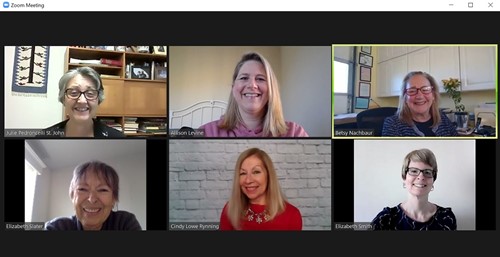
A screen shot of our group, that's me on the top left. Our group in order after me:
Allison Levine, owner of Please the Palate and a freelance wine writer and podcaster, Southern CA
Betsy Nachbauer, owner of ACORN Winery, Healdsburg CA
E Slater, owner of InShort Direct Marketing and co-founder of Wine industry Network, Oregon
Cindy Lowe Rynning, owner of Grape Experiences and a wine writer, Illinois
Dr. Elizabeth Smith PhD, TravelWineChick and freelance wine and food writer, Napa CA.
While wine is the obvious thread we all have in common I’ll point to wine education as the deeper link. We all one way or another write or talk about wine and educate through our various roles. Food is another affinity especially when one of us mentions chocolate.
The span of subjects over 50 plus meetings was focused on COVID guidelines, vaccination news, which tier we were in Red? Orange?. Next up could be the politics of the moment, the shared name of three of our members (Elizabeth), how tall we are, hair styles of the past, or our background stories. The conversations always included advice, listening, swearing, lots of laughter, tears, shared frustrations, celebrations, opinions, commiseration. Pretty much what we would do if we met in person.
I will tell you we experienced many milestones in this time together. Some life changing, some happy, some sad. Examples of the arc were always reflected in the latest turn of the pandemic. Two of us had tasting rooms that open/closed/opened again and then were put under strict and limiting guidelines. Some of us were very careful because of compromised health and followed the hard and fast rules to protect others as well as ourselves. E had just moved to a new state-a couple of weeks before the pandemic began-and because of the situation she and her husband have made exactly one friend who had moved just before them into the same building. Allison took us with her (via her phone) when she received her first and second vaccinations. Birthday milestones were cheered on-one each turned 50, 60 and 70 but I’m not telling who.
Other exciting changes or additions in the last year included: Allison and Cindy began Crush on This a weekly video series focused on different wine subjects. E wrote a book which gathered her knowledge from teaching classes about selling wine in the tasting room and is soon to be published. Because of the pandemic Elizabeth changed her career course and became a freelance author of numerous articles on food and wine as well as started her own pet sitting service, named after her beloved cat Einstein who passed in October. Betsy worked hard to change and stay afloat amidst the challenges of operating during the pandemic and with much success.
Just as in real life, loss was a theme throughout the year with family members and cherished pets passing. The most memorable was when one of our group received a phone call during our chat and heard the news her mother had passed. I can’t tell you how painful it was but it was a moment witnessed by the five others, sharing in her grief and touching each of us deeply.
This month Allison brought a group of media friends (she would want me to include that all of us were vaccinated) and had dinner at Pedroncelli. Betsy and her husband Bill were co-hosts. All brought together by the COVID Coffee Chat experience.
Connection. This is how it all started. During the pandemic we craved what we were missing and found ways to reach out and bond. We will continue with our chats and one day we will gather together around a table at a café. Over the last year there was a lot of hope for things to change, for the guidelines to lift, for travel to begin again. The blessing in disguise was the gift of time and getting to know someone on a deeper level. How about you, do you have a similar pandemic experience you’d like to share? I would love to hear from you!
-
Note from Home: Water Matters
June 2, 2021 10:35
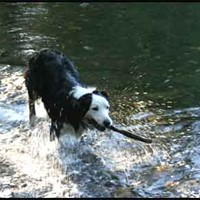
I have been back at my office at the winery now for two months. In those two months I have waited and watched as our Mother Clone Zinfandel vines began their journey toward vintage 2021. It will be our 94th year of bringing in grapes and the upcoming crop is now in full swing.
Water matters and, as farmers, we are water dependent. Since grapevines are what we farm, we rely on the annual rainfall to provide most of what is needed to get from point A-the beginning of growing season to point B-harvest. Last year, besides COVID, the lock down, and the late summer fires we went through here, one bit of information slipped the news headlines: our first year of drought had already occurred.
Last October, as the 2019/20 rain season ended and the next one began, I checked in with the predictions on what type of winter to expect. Was it going to be an El Nino or La Nina year? Meaning with the first choice we’d get a normal amount of rain or one with very little. La Nina graced us with her presence. When you total the combined rainfall between the last two years it equaled one year of average rainfall-32 inches, split between the two.

The lifecycle of our vineyards depends on drip irrigation to help the vines along as spring turns into summer and will be especially important this year. Measures are taken to determine we aren’t using too much of this precious resource-and in fact the vineyards used to be watered by overhead irrigation and cast a much wider swath (and used a larger amount of water) than we do now with the system close to the ground and emitting directly into the soil.
Water cycles and climate change.
Since many of you have been reading my posts for a while (much appreciated by the way) you’ll remember I follow the weather cycles. We have had several droughts and several rain-filled cycles throughout the years. In our time here we have seen two five year droughts along with the shorter two and three year cycles. We have also seen amazing rainfall well above average (remember 2017?, 1982?). The quality of some of those vintages are remembered with great reverence, like 1976 and 2015 chief among them as well as others with perfect conditions like 1978 and 2018. The climate has changed and will continue to do so. Preparation for the future is key. Finding which varieties are most drought tolerant or which is the best technology to help conserve water will pave the way for future re-plants.
We continue along the growing season with these incumbent thoughts: how warm is the summer going to be? How many times should the vineyard be watered? What about the vines-will they tolerate another year and what will production look like? These are all farmer’s concerns as we head toward what we hope is a trouble free vintage.
Conserving water, which in my opinion should be practiced at all times and in as many ways as possible whether a farmer or me in my home, is so important all around California and beyond. Our county has asked us to reduce our water usage by 20%. I know there are farmers up and down the state making difficult decisions. Not just grapes but all the other types of farming from almonds to cows. Whether we admit it or not, we are in this together.
Here is the report from the state of California for full on weather geekery and charts:
https://water.ca.gov/-/media/DWR-Website/Web-Pages/Water-Basics/Drought/Files/Publications-And-Reports/DroughtBrochure2021update_ay11.pdf -
Note from Home: The Schotzki Connection
April 26, 2021 13:51

Thank you to all who sent in their kind words at the passing of my brother-in-law Jon from Multiple Myeloma. I sent them along to my sister Joanna and his family and they are thankful for all of them. In February I visited with Jon to have him tell his story and he chose to talk about his alter-ego Schotzki. I didn’t know about this part of his life and, if you knew him, you won’t be surprised.
It is the late 1990s and Jon is working at Buona Sera, in his hometown of Petaluma. He meets co-workers who are writers and performers, beatniks and poets. He was hooked. He had never written free form poetry before. He was enthralled by the quest to find what it is they are talking about, the ideas, following the words and thoughts and how they expressed them. Sometimes the mystery was the greatest part of what they were doing. He loved word play and, pushing himself, he started writing and hit his stride.
Some feeling or impulse prompted him to take poetry to the people. He developed a ‘poetry slam’ summer tour. He went to work raising money to support this enterprise, from selling concert-style tshirts to books donated by local book stores, anything to fund his dream. Armed with a mic and an amplifier donated by a Cotati music store it began. Sometimes he performed from the back of a flatbed truck.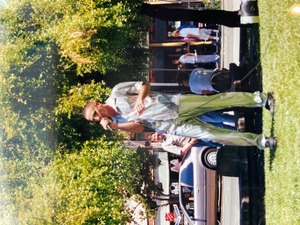 He produced four shows a month for four months around the county, in front of Safeway, Starbucks, or Aromas Roasters Coffee (where wife Joanna recalls the poetry slam and that she waited on them- before they got together). Schotzki was an androgynous persona and through him Jon lived out the fantasy of a David Bowie-inspired character. Tag line: Schotzki is your mother, Schotzki is your father. Let me guide you to rebirth and new life.
He produced four shows a month for four months around the county, in front of Safeway, Starbucks, or Aromas Roasters Coffee (where wife Joanna recalls the poetry slam and that she waited on them- before they got together). Schotzki was an androgynous persona and through him Jon lived out the fantasy of a David Bowie-inspired character. Tag line: Schotzki is your mother, Schotzki is your father. Let me guide you to rebirth and new life.
Later Jon continued the concept with a group called Band of Mayhem. He recalled a woman who had Tourette's Syndrome but when onstage it disappeared while reciting her poetry. He also performed at Petaluma’s Phoenix Theater. One of his proudest moments was when he opened for poet Lawrence Ferlinghetti. His performance included one of his signature poems Pistachio (Jon performs the poem in this video clip taken at Joanna's birthday party a few years ago), and handed out pistachios to the crowd. He recalls it was an amazing time. People were open to watching the shows. Teachers invited him to their English classes-where he showed the kids that poetry was alive not stale. He was very proud of his work. “If you immerse yourself in the arts then you progress and hold onto your true self; your true values.”
His friend Matt Harstead was the body guard/production assistant and Govind Davis his partner in crime who helped produce the slam shows. They never counted the numbers of people who attended but they always drew a crowd. The last show was held at the square in Sonoma. He had five guest poets and a couple of bands; Schotzki was the final act.
He continued writing poetry and later began creating digital art on his Instagram account @schotzki. Since his cancer diagnosis he filled his canvases with thoughts and feelings that he needed to express. These became much more personal to him. He wrote pages of poetry. As he told me: not gotcha poems but ideas to get people riled up or laughing hysterically. He enjoyed making people laugh and loved it when they ‘got’ the humor. This connection was a huge part of both Jon and Schotzki.
Jon finished our visit with, “Cancer makes you think long and hard about what you have done with your life. It was and has become very personal art. I accomplished what I wanted to do. In my life I have done that in other areas; from Schotzki I was given an amazing ability to connect.”
I’ll note his roles at both Bistro 29 and Pedroncelli encompassed his love of people and making them part of the performance of the moment. When you dined at Bistro 29 you felt part of a wonderful experience orchestrated by Jon. When you visited the tasting room the give and take was the key. As Wine Club Manager talking on the phone, he made you feel a part of the family. His hearty laugh still echoes in my memory. Most importantly he wanted the back and forth of the connection. Three years ago, when making the transition from Sonoma County to Grass Valley, he stayed with Jim and Phyllis, his in-laws, and became their ‘son’ for those months. He reminisced about Phyllis' excellent dinners, their lively conversations each night and lots of armchair coaching of ball games with Jim. He took them out of their comfort zone as only Jon could do.Later this year we will be bottling up a 2019 Zinfandel and adding a label commemorating Jon and Schotzki. It will feature one of his digital canvases. All proceeds will go toward Multiple Myeloma research.
-
Postcards from Home: D2E
April 26, 2021 13:36
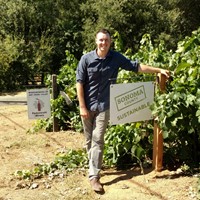
This series began one year ago at the start of the pandemic when I wanted to share what is going on each month at the winery or in the vineyard. They are snapshots of life in and around our little corner of Dry Creek Valley. I have mentioned before that I send my grandsons postcards from the road—I am on the lookout for a postcard that captures the place I have traveled to so I can share the experience with them. These do the same thing—bring a bit of Pedroncelli to you!
April is known as Down to Earth (D2E) month in California with thanks to the Wine Institute, a group dedicated to supporting and lobbying for the state’s wineries. We have been a member for decades and I am a member of the board representing Sonoma County along with other vintners. Over 1000 wineries belong to the group stretching from border to border. Wine Institute also began the Sustainability program and have chosen to focus on this for D2E month.
D2E celebrates sustainability in the vineyards and wineries, showcasing green from grape to glass all around the state. You’ll find some great information here as well as many live presentations throughout the rest of the month. At Pedroncelli spring is in the air—our vines are waking up, budbreak is taking place as each variety, from Sangiovese the first out to Cabernet Sauvignon, takes its turn to push out and reach for the sky and the upcoming vintage.
Alto Vineyards Sangiovese
Mitch, Vineyard Assistant and 4th Generation Member, sent me photos of the first vineyard to begin budbreak. While the other varieties weren’t too far behnd, our Sangiovese is almost always the first out. In fact the vineyard crew delays pruning the vines for this very reason—they are the last to be pruned and the first to push out buds. It helps protect the new growth from possible frost damage. I guess they aren’t the only ones ready to start the vintage.
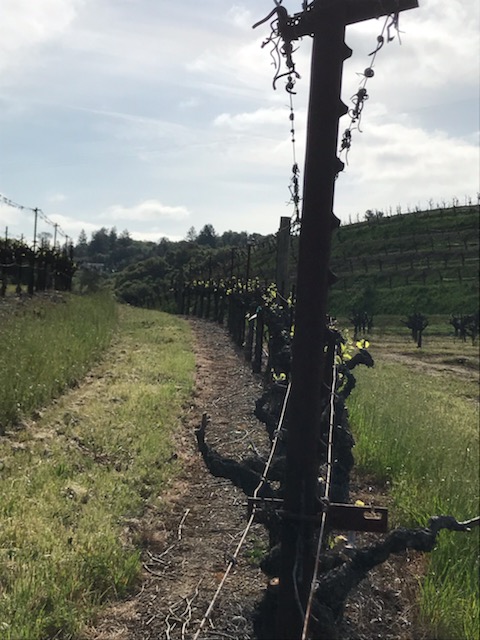
Mother Clone Zinfandel
The three generations of Zinfandel on the home ranch have begun another year of the growing season. The vines, ranging in age from over 100 years to the youngest at 8, were a little slow in waking up but now you’ll see they are in full swing heading toward vintage 2021. The beauty of this old vine is in the gnarled arms-the knots indicate previous canes and shaping of the vine which has produced fruit for nearly 40 years...and counting.
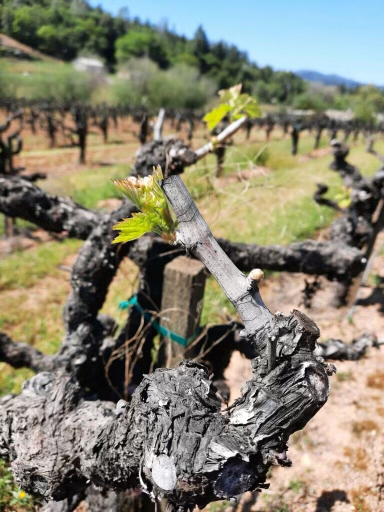
On Being Sustainable
We were certified sustainable in 2017, our 90th anniversary. This reflects our time here in Dry Creek Valley—the three ‘e’s of sustainability are Environmentally sound, Economically feasible and socially Equitable and is woven into our legacy. Mitch Blakeley, fourth generation, became the coordinator of this program and works with the auditor each year to further the green footprint in both the vineyard and winery. Cover crop is just one of the ways we tread lightly in the vineyard—also less tractor work which equals lower emissions. All of these work toward a better future for all of us. For more about what we do visit here.
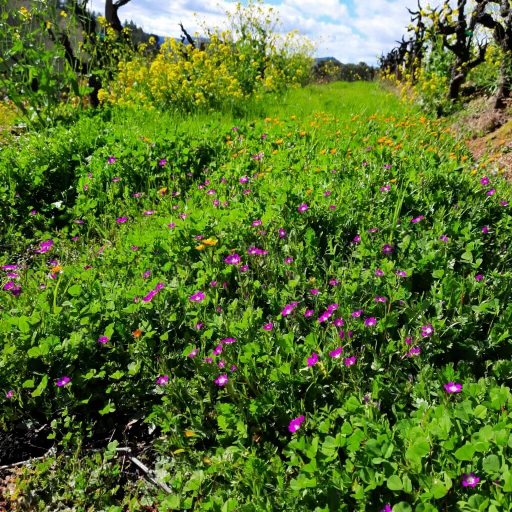
April Flowers
It just wouldn’t be fair to close this Postcard series without a photo of the beauty flowers bring to our little corner of the world. Bees depend on the flowering rosemary around our tasting room and other plants in and around the winery. The cover crop, recently tilled under to feed the soil with necessary nutrients, is all part of being down to earth.
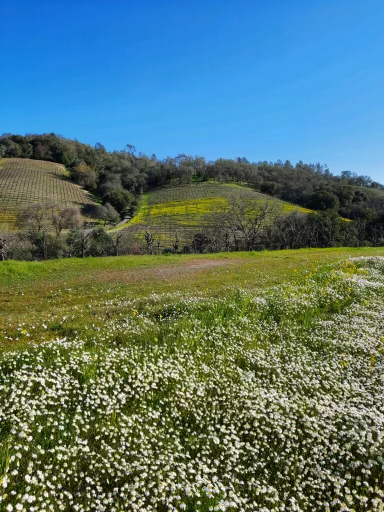

-
The Schotzki Connection: Stories from our Friends
April 23, 2021 11:03

Jon Brown was our Tasting Room Manager and later on our Wine Club Manager. When he passed away in March we received hundreds of responses, many of them with great stories and photos. Thanks again to everyone for sending in your notes and stories. He will be missed by many of us and these memories will go a long way to heal the loss.
Two stories from Diana & Sparky will lead off along with many other notes and memories of Jon:
We met Jon the very first time we 'discovered' Pedroncelli. It was late in the day, near closing although we didn't realize. There was only one car in the parking lot, full of political stickers. He welcomed us openly and when we mentioned we were from Alaska we got onto a whole political discussion of Ted Stevens (a fan of Pedroncelli), we explained how our personal politics are less aligned with our state but that Ted was always a hero here and laughed about the car in the parking lot (his as it turns out) and ended up having a lively, politically aligned, musically aligned and very cheerful conversation over wine for probably the next hour. By the end of it we were hugging and felt as though we had truly met a kindred spirit. Every time we came down we tried to time our visits to Pedroncelli at a time that Jon would be less busy and we could resume our wonderful discussions of music, politics, tales of our 'westy adeventures' in Alaska (our Westfalia van-we broke down a lot) and the state of the world. I remember clearly one time when we had not known to call in advance we walked into a somewhat crowded tasting room, saw Jon across the room and as soon as he saw us he paused, laughed, threw his hands up in the air and exclaimed "what Alaska you don't call to let me know you are coming??!!!". Ever after that we did and always had a great time visiting with him.
The second one, where Diana notes she hopes she doesn't get anyone in trouble: We showed up one day mid-week with a picnic, we didn't often picnic at Pedroncelli preferring to come late in the day when we might be able to talk to Jon longer if possible as things were quieting down. But we were on bikes that day with our sandwiches and figured 'why not? we can always come back tomorrow to hang longer!". But when we got there it was clear that a giant party was in the gazebo area. We went in nonetheless to pick up wine we could retrieve later with the car and to hang out with Jon. Over tasting we asked about the party (a wedding rehearsal I believe) and laughed that it was our first time we were going to picnic at Pedroncelli but got skunked! Jon refused to take no for an answer and said 'I have an idea, follow me"...curiously we followed him out the door down the drive and into the next door house...where Jon said "here help me carry these"...gesturing toward the dining room furniture!!. Warily we said "umm it's ok we don't want to be any trouble or anything it's no big deal"...and Jon cheerfully offered "no it's all fine it's my brother in law's we will put it back after!" Whereby we moved a table and chairs from the house into the shade behind and had our picnic there! :-)
He knew his wine, he was funny and his restaurant recommendations were spot on.
A note to Colin (our Wine Club Manager trained by Jon) from a club member: I became a Club Ped member in 2005 after Texas (where I then lived) legalized interstate wine shipments to individual customers. I became used to calling/writing Jon during his tenure managing Club Ped and recall his friendly positive dedicated attitude toward his work and ClubPed. I was concerned when he left Pedroncelli how Club Ped would be managed but after a few months communicating with you I realized Jon trained you well!
Enjoyed knowing and working with him over the years. He always had a good sense of humor.
Jon will be deeply missed! His personality was wonderful and he always brought a smile to my face.
We remember Jon and his warm voice on the phone when we called in to order a case of your good Zin.
He and I had many phone and email "conversations" when my Club Ped order needed to be sorted out. I always knew that if I called Jon, the issue would be resolved!
He was a very kind person that added a depth of service rarely experienced in this day and age.
Jon was the one who I met and took me through my tasting when I first visited Pedroncelli. He was kind, generous with his time and extremely friendly and accommodating and made a strong impression on me and was the reason I made the purchases I did that day!
He was so helpful to me with Club information and so kind when we needed to stop our Club shipment a few years back due to an over stock of wine. He and I had a chuckle about that.
The first was back in the summer of 2016 for our 25th anniversary. Pedroncelli was out first stop, and Jon had made an appointment to meet us and give us the tour. We had so much fun with him that day- he was so enthusiastic, energetic, and treated us like long time friends. Still a highlight to this day.
As club members, we had the privilege of communicating with Jon on many occasions and he was always ‘Johnny’ on the spot! I love his nickname (Schotzki) and I too find myself ‘in the music’.
Your records may tell you how long I’ve been buying wine from Pedroncelli, and thus when I first got to know Jon; it’s been many years. We hit it off from the start—I called in my orders then and he always had a friendly word (or two) and good advice. He helped me through the weddings of our two daughters and innumerable other special occasions. We finally traveled to Sonoma Valley in 2015 (after I got through treatment for lymphoma, hence the hair style), and my wife and I were able to meet Jon (photo below). It was a high point of our trip. I miss Jon as am sure many others do.
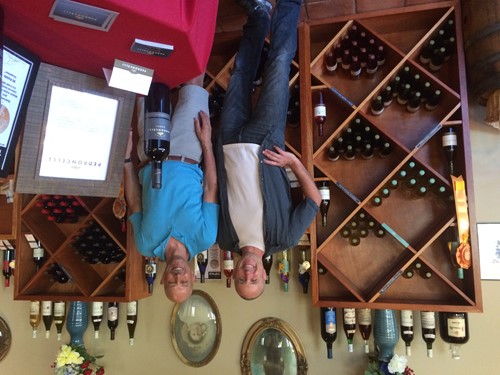
And Jon with guests from Florida and Maine at the crushpad with Colin, Lance and Mitch during the harvest of 2018.

-
Note from Home: Engage
April 12, 2021 10:08
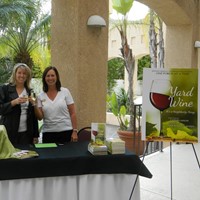
Do you feel like you have been hibernating during the pandemic? I do. Spring is here and bringing warm days ahead. I am itching to break out of my shell and go on more hikes, maybe some biking and some downtime outdoors as we approach summer.
 As one of my favorite starship captains says-it’s time to engage! There are many ways to engage in the world whether socially distant or not. Sinking your hands into fresh earth to plant something, take a hike and commune with nature, become innovative and wake up to a new routine, or break out and reinvent yourself. Having fun is important too-it helps us to engage with each other on another level. For instance, playing Scrabble with Carol, my sister-in-law, became a highly competitive and fun time as the more we played the more we learned about each other. Who knew Xis is an official Scrabble word?
As one of my favorite starship captains says-it’s time to engage! There are many ways to engage in the world whether socially distant or not. Sinking your hands into fresh earth to plant something, take a hike and commune with nature, become innovative and wake up to a new routine, or break out and reinvent yourself. Having fun is important too-it helps us to engage with each other on another level. For instance, playing Scrabble with Carol, my sister-in-law, became a highly competitive and fun time as the more we played the more we learned about each other. Who knew Xis is an official Scrabble word?
Beginning last summer one of our neighborhood cul de sacs held a weekly yet socially distant gathering around their court-they brought out chairs, tables, food and wine. They took a break in winter but last Saturday, as I walked down the street, I saw they were back together-still distanced. A book came to mind as I passed them: Yard Wine: It’s a Neighborly Thing "Bringing America’s Neighborhoods Together One Porch at a Time."
It was originally published in 2011 and is pairs nicely with the theme of my note. I think it is a charming book and idea worthy of a rebirth as we move out of our pandemic guidelines and into more contact with our neighbors and friends. And it includes wine!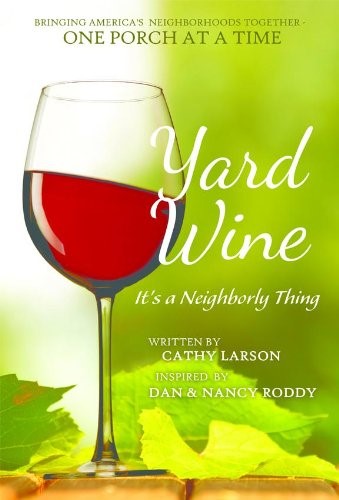 An excerpt from their book: “Do you long for neighborhoods of the past? When neighbors knew each other’s names, visited on front porches, and enjoyed one another’s’ company? Now is the perfect time to return to these “good old days” that provided great personal fulfillment, greater conversation, and lifelong, face-to-face friendships. In Yard Wine: It’s a Neighborly Thing authors Cathy Larson and Nancy Roddy show you how to create your own Yard Wine neighborhood, use the power of Yard Wine and find the secret to happiness and a rejuvenated spirit in your own front yard — starting tonight! All you need is an open heart … and an open bottle of wine. Cheers!”
An excerpt from their book: “Do you long for neighborhoods of the past? When neighbors knew each other’s names, visited on front porches, and enjoyed one another’s’ company? Now is the perfect time to return to these “good old days” that provided great personal fulfillment, greater conversation, and lifelong, face-to-face friendships. In Yard Wine: It’s a Neighborly Thing authors Cathy Larson and Nancy Roddy show you how to create your own Yard Wine neighborhood, use the power of Yard Wine and find the secret to happiness and a rejuvenated spirit in your own front yard — starting tonight! All you need is an open heart … and an open bottle of wine. Cheers!”
The authors share stories of relationships born from time spent outside the house, connecting with their neighborhood in a spontaneous way. It is the simple concept of sitting outside (perhaps outside of your comfort zone too) and making your front yard your front room. When we first discovered this concept Ed and I followed their example-we sat on our front lawn, chatted, sipped wine and greeted passersby. It wasn't as widely accepted back then so I think we need to get our Yard Wine flag and fly it, set up lawn chairs and greet and talk to our neighbors walking by our home. Just in the course of pandemic we have new neighbors, times have changed and it's time to reconnect or make new connections. And of course invite them to sip some wine with us. Now where are my Go-Vinos?
Wine is engaging. Wine is fun. I can't think of anything more inviting than pouring a glass of wine and sitting down after a long day to relax and connect-how about you? Send me your photos from your front porch, lawn, deck or stoop and I'll share them. Sip, visit and engage!Note: the book is no longer for sale but it can be found on Kindle, via Amazon.
-
Vintage Notes
March 30, 2021 16:22
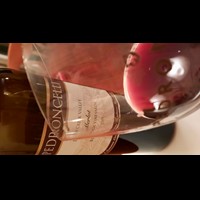
This is the first of a monthly blog post on wines from our cellar here at the winery. Ed, Colin and I have been taking apart stacks of wines in our warehouse and inventorying them. We of course need to taste them to make sure they are doing fine, drink now or forget about it.
It began last month with Open That Bottle Night but as we delved into the cases of wine stacked in and around the warehouse we realized doing some tasting notes on these gems would be a good thing to have here on Vino in my Dino.
2009 Merlot
Cork Finish
This was a nice surprise. The very mellow wine with touches of red brick around the edges of the glass. Softened by age this Merlot still has the stuffing to age another year or two. The beauty of this gem is it is ready to drink now should you have some in your cellar-a few more years will be okay as well.
2002 Alexander Valley Cabernet Sauvignon
Cork Finish
From the Morris Fay vineyard this is a wine that has aged quite well. Notes of tobacco, leather and a nice fruit core of cherry on the aromatics as well as flavor. A long finish is framed by softening, but not too soft, tannins signaling this wine will age well for a few more years.
2001 Block 007 Cabernet Sauvignon
This is the first year we made a small lot wine from this block. And I am here to tell you this has aged beautifully. Notes of dried herbs linger on the nose along with touches of plum and black pepper spice.
2016 Signature Selection Chardonnay
Screw Cap
Not much color change-a deepening gold perhaps from the pale yellow of first release. Still lively with mellowed aromatics of melon and apple. Acidity is still bright, the flavors are rich and the finish is heightened by the perfect balance of fruit and acidity.
-
Making Connections: Manuel Diaz
March 30, 2021 16:15
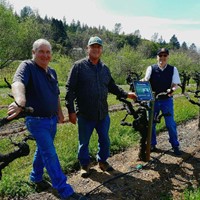
The other day my sister Lisa shared an idea she had to highlight our staff by telling their background story. She is a fan of the PBS series Finding Your Roots so she envisioned these stories as connecting our co-workers between where they came from and where they are now at Pedroncelli.
Serendipitously I already had something in the works about our Vineyard Foreman José 'Manuel' Diaz, who had been featured as an Employee of the Month by the Sonoma County Winegrowers in the local paper. Manuel was nominated by Jim and Lance for the Vineyard Employee Recognition Award which is awarded for individual achievement and exceptional performance. He has worked 37 years here and continues to love what he does. As the article said: "Sustaining a family farm requires love, commitment and hard work. We are proud to recognize the people who help us grow the world's highest quality winegrapes."
The photo above shows Jim Pedroncelli presenting Manuel with a framed copy of the honor along with Vineyard Manager Lance Blakeley. Here is Manuel's story.
Manuel was born in the village of Tumbiscatío, in Michoacán. His grandfather had moved there from Spain and his father, Feliciano, grew up there as well. The path to the U.S. began with the Bracero program and Feliciano spent a few years in this program and then made a permanent move. Manuel, at the age of 18, followed his father in 1978. His first day in Dry Creek Valley was March 23rd—and he went to work for Raymond Burr, the late actor, who later on planted vineyard.
A short time later his father came to work for John Pedroncelli and Manuel followed in the early 1980s. He first worked on the bottling line and then in the cellar for about 10 years. He then made the move out into the vineyard when his father was no longer able to work there and later on became our Vineyard Foreman.
Trials and Triumphs:
By working in the cellar first he realized how important it was to have quality vineyards. Learning how to get the best grapes through farming practices was key in the connection. He says it is eye opening what goes into why you do certain things in the vineyard (fertilize, pruning, crop cover) in order to make great wine.
He became a home winemaker for a vintage or two and made late harvest Sauvignon Blanc. He realized it was easier to make red wine than white wine as it is more delicate an operation and decided to give up his winemaking dream.
His philosophy is very similar to John Pedroncelli's when it comes to how we work together. He considers everyone as the whole team-while each contributes to the work it is the crew together that makes it all flow from the vineyard to the cellar. Another challenge he has met is putting together the harvest time crew for picking grapes. A bigger crew brings in many personalities-sometimes as many as 25. This is the reason he was nominated for the award-he is able to organize, talk to and encourage the different people coming together for the short time at harvest so things will go smoothly.
Another challenge he has met is putting together the harvest time crew for picking grapes. A bigger crew brings in many personalities-sometimes as many as 25. This is the reason he was nominated for the award-he is able to organize, talk to and encourage the different people coming together for the short time at harvest so things will go smoothly.
I have seen him at times in the evening driving along the vineyard avenues-he says that is when he reflects on the day, looking for what needs to be accomplished, moving toward the next project.
Other milestones include producing a video about Adelante, a program aimed at educating and encouraging Hispanic youth, meeting and marrying his wife Norma in 1989, and the birth of his five children. Quite a few connections from a small village in Mexico to Pedroncelli in the span of 37 years.
I will continue the stories from more of our staff and beyond all the while keeping in mind your connection to us and the journeys we have all made. -
Postcards from Home: Bottling Up
March 30, 2021 16:10
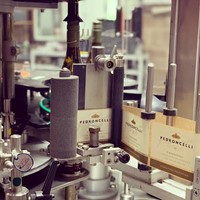
March brings us rain, spring, setting our clocks forward and, at Pedroncelli, the cellar crew is busy getting wines ready for their final stop before coming to you—the bottling line. We usually begin bottling the white wines from the previous harvest in February followed by the red wines from the previous harvest as they finish aging—some see 12 months while others a little longer. The bottling schedule lasts for about six months—just in time to get ready for harvest and all that brings.
From winemaker Montse Reece is a snapshot of preparation to bottle. “One week before bottling we rack the wine off (with either bentonite for white wines and gelatin for reds) and filter the wine. All wines, except the Port, get cross-flow filtered. After filtration I adjust the sulfur levels for bottling and check the specific gravity that I use to check the fill levels during bottling. We order nitrogen to purge the empty glass bottles before they get filled with wine.
Bottling day starts with the sterilization of the line (pipes/filler bowl/filters). During bottling we check fill levels and adjust, if necessary, the oxygen levels in nitrogen purged bottles and in wine to be sure we are under 1 ppm (part per million) O2, vacuum pressure on the corks, torque pressure in the screw caps and filters pressure. Then the wine is packaged and stored until release.”In Line
Montse mentions nitrogen to purge the bottles and here they are in line to begin the filling process.
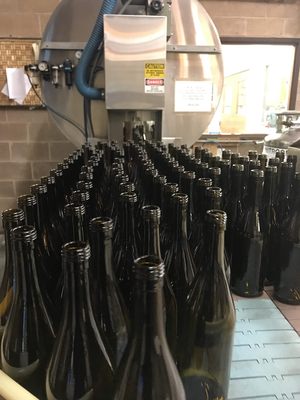
The Line Up
Once filled and sealed with a screw cap or cork, they make their way to the labeling section.
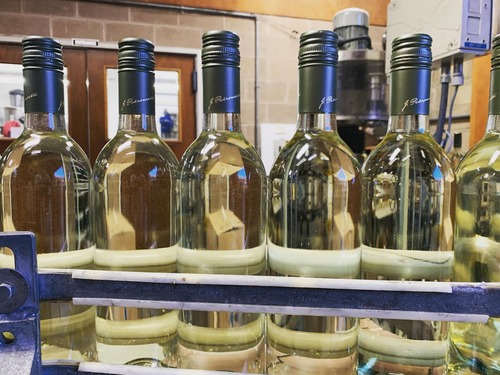
Labeling Up
In the early days there was the label and then there was glue, slicked onto the label as it was placed on the bottle. If these were on white wines they’d eventually slide off after being on ice for an hour or two. Today self-adhesive labels are the way to go and do their part to stick when submerged in that tub of ice at your next picnic.

The Finished Product
Our family of wines waiting for you to try one—we make many choices so there is something for every palate and taste.
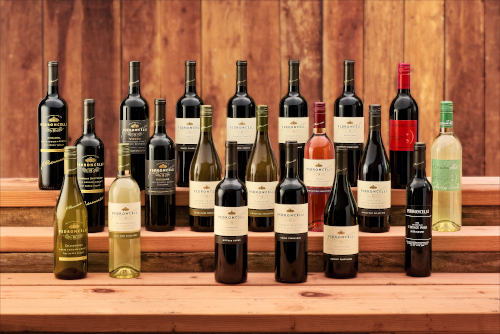
-
PurpleRedOrangeYellow
March 30, 2021 16:06
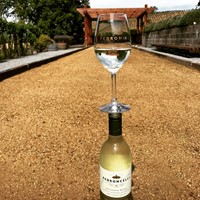
Tuesday, March 16, marked the one year anniversary of the pandemic for us. We closed our Tasting Room, battened down the hatches, followed the news very closely and here we are a year later. We started off not knowing how all of this would go, how many weeks we'd have to wait. And I think many of us thought it would all be over soon and never considered a full year of opening, closing and opening back up again in our tasting room as well as restaurants, hair salons and hotels and beyond. Who could have predicted all of this?
In a recent zoom session one of my friends, who lives in California, rattled off the colors of our COVID tiers in a sing-song voice and it stuck with me, hence the title. The colors Purple, Red, Orange, and Yellow are assigned to the tiers by the state of California with differing levels of COVID statistics. Purple is the most impacted and of course yellow signals better days ahead. The tiers determine how we operate as a tasting room and how restaurants and retail can operate as well-masks and physical distancing are still part of this time. I hear a Green tier is being develped as the final color for giving us all a go ahead-I for one am looking forward to that.
On Sunday as we spring forward the county will go from the Purple to the Red tier. At this time there is no difference in how we operate-still outside tasting by reservation. Moving into the Orange tier means we'll have inside tasting again. Our state and county officials continue to work toward reopening the schools and other businesses so hard hit by the shutdown and the colors will shift slowly from Red, to Orange then Yellow.
All along the cellar and vineyard staff kept going because agricultural work is considered essential. They worked together to keep safe and are now on their first and second vaccinations thanks to county trade groups like the Sonoma County Winegrape Commission being at the forefront of providing the vaccination information. In fact I just heard the town of Geyserville has the most vaccinations per person than anywhere else in our county.
COVID operations continue and include maintaining and keeping areas of use clean, very clean. Sanitizer now complements the soap dispenser and there is a bottle in every possible spot to keep on sanitizing. Gary has become an expert with these guidelines and the tasting room crew continue to welcome guests and keep them comfortable as they take in the refreshing outdoors and taste through a flight of wine.
What did we learn from this time?
Did you know that the common cold and flu has been cut back by some 85% because of the masks, sanitizing and social distancing? That speaks volumes.
People like to order Pedroncelli wine! We have seen surges at different times over the year but overall we are seeing a large number of orders even today via online and phone-this avenue of ordering has become the norm.
You really want to come back to visit. Our virtual events were popular but don’t replace the ‘real’ thing of being in each other’s presence. There is nothing like sitting down to an experience here at the winery and tasting wine at the source.
I learned I could visit with different accounts in my markets through Zoom and it was just as fun talking to folks and tasting through the wines with me in Healdsburg and them in their stores or restaurants. I learned how things are going in each of their cities or towns across the country.
What did you learn? My inbox is open, as always, to hear from you julie@pedroncelli.com By this time next year I'll look forward to seeing many of you in person.
Categories
- COVID
- Follow the Vineyard
- Note from Home
- PairItWithPed
- Pandemic
- pedroncelli
- Port
- Postcards from Home
- Pruning
- Seasons in The Cellar
- Tasting Room
- Thanksgiving
- Vintage Notes
- Winemaking
- Women's History Month
Recent posts
-
91 Years Later
-
Come Over October: It's About Community
-
Come Over October
-
A Legacy Continues!
-
Everything Old is New Again
Popular tags
- food and wine
- Harvest 2022
- Pruning
- Habit
- Sauvignon Blanc
- Homecooking
- French Oak
- Lake Sonoma
- Recipes
- Easter
- cooking with wine
- Library Wine
- Down to Earth
- Four Grapes Port
- Merlot
- Bushnell Vineyard
- Cookies
- COVID19
- Mother Clone
- note from home
- Schotzki
- Finding Your Roots
- newsletter
- Block 007 Cabernet Sauvignon
- OpenThatBottleNight
- family
- cheese
- Anniversary
- Cabernet Sauvignon
- Crop set
- Cellar Master
- Sonoma County
- Follow the Vineyard
- Courage Zinfandel
- Estate Vineyard
- Reserve
- Rosé
- Pantry
- Pedroncelli
- COVID Coffee Chat
- American Oak
- 1974 Cabernet Sauvignon
- Pandemic
- Dry Creek Valley
- Barrels
- Holding steady
- PairitwithPed
- Seasons in The Cellar
- Oak
- Heat wave





